6X9 Car Speakers For Bass And Sound Quality
What are the best 6×9 speakers for bass and overall sound quality? Well, there’s no definitive answer as it all depends on your preferred sounds and taste in music.
But something should be cleared up immediately. There’s a myth that 6×9 speakers don’t drive the best sound quality and lack in bass. And while this is true for some, the same can be said of all sized speakers, but getting some good quality 6 by 9 speakers to suit your taste is very possible.
Considering most people in the modern, industrialized world spend hours a day in their vehicle, it is definitely a “place” that deserves a decent investment in every arena.
Driving can be boring, especially when you’re stuck in traffic. From comfort to entertainment, your ride should be as pleasant as possible and there’s nothing better than blasting out those tunes, and a good set of 6×9 speakers will make every drive a better experience.
Choosing the best car stereo system isn’t easy, especially as there are a multitude of quality 6×9 speakers on the market all enjoying different strengths and weaknesses. So with a laundry list of numbers to decipher, I have taken it upon myself to provide a list of the 10 best 6X9 car speakers for good bass and sound quality.
And after the reviews, I have also put together a comprehensive buyer’s guide, to help you make a more informed decision in your quest for that perfect listening experience.
>> The Best Jet Ski Speakers <<
The Best 6×9 Speakers For Sound Quality
Kicker 43DSC69304 D-Series 6×9 Car Speakers
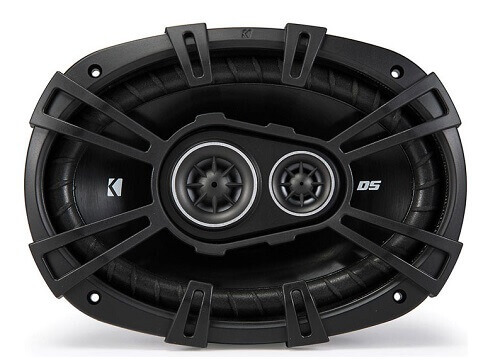
The first 6×9 car speakers on my list come from Kicker – a brand known for producing good quality bass in the audio industry. Don’t think they’ll replace a subwoofer, but for anyone who likes a bit of bass without going the whole hog should at least consider these.
These Kicker 43DSC69304 D-Series are some of the best selling 6 by 9 car speakers on the market and it’s easy to see why.
The 4-Ohm speakers have 90W RMS power handling per pair and feature EVC (Extended Voice Coil) technology which helps eliminate stray magnetic flux and ensuring the sound produced is clearer than standard voice coils.
The triaxial (3-way) speakers also feature a 0.5 inch PEI domed tweeter, which hits those high notes beautifully, allowing the stiff polypropylene cone midrange woofers to hit low bass notes as low at 30 Hz. In fact, the Frequency Response is an impressive 30-20 kHz, and with a Sensitivity of 92 dB it means these little beasts will drive a distortion-free soundscape.
All Kicker D-series speakers are a universal fit and easy to install into the same size speaker slot. Simply, remove your factory speakers and install these powerful speakers in the same place without having to screw any holes.
You’ll be looking a long time to get better 6×9 speakers for bass. And at this price point, these Kicker triaxial speakers offer excellent quality mids, highs and some fantastic bass output with high-quality crisp and clean sound.
- Very crisp and clean sound
- Impressive bass for 6×9 speakers
- Great RMS power handling
- Nothing to dislike at this price
Infinity REF9630CX – 6×9 Component Speakers
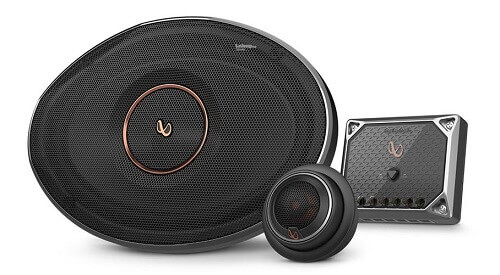
When it comes to quality, Infinity is quickly taking the car audio market by storm. While it may not have the same storied past as a Kenwood, Alpine, or Pioneer, Infinity more than makes up for it by producing one of the best 6X9 component speakers on the market today.
And of course, all that quality you’d think you might be stung in the pocket, but for something that produces bass above expectations, and tweeters that are crisp and clear, they’re very reasonably priced.
New to the market in late 2020, these 6×9 component speakers drive some power. With 125W RMS per speaker is probably needed for the oversized Plus One woofers, which offers more surface area for higher bass response and enhanced midrange that will make a huge impact on any car stereo system.
The 3-ohm 2 way component system comes with crossovers, of course, and edge-driven textile tweeters for smooth, clear highs. The tweeter boasts an adjustable output level control for high-frequency optimization, which will give you more control to sculpt the sound you desire.
A frequency range of 46Hz-21kHz is actually pretty pedestrian, but if you’re running these with a full stereo set up, they make a great addition, and will add excellent ambience to your soundscape.
At 93 dB the sensitivity is impressive, and with the oversized cones the result is accurate music reproduction, no matter what genre you’re playing. For a powerful component speaker, these are very reasonably priced, and the power they drive is impressive.
That level of power, however, I would recommend getting these if you have, or intend to get an external amplifier, so if you’re on a budget these might not be the best 6 by 9 speakers for you.
- Clarity is great
- Oversized woofer for extra bass
- Reasonable price for 6×9 component speakers
- An amplifier is necessary to get the benefits
- Crossover is bulky
Hertz CPX 690 PRO – Powerful 6×9 Car Speakers
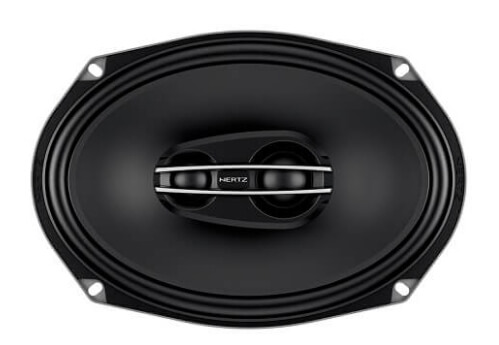
As the most expensive speakers on my list, you expect Hertz to perform better than any other competitor, and in this regard, your expectations will be met and likely exceeded.
These drivers are the most powerful and best sounding 6×9 car speakers on my list. Granted, all of that power will only see the light of day if you provide an adequate amplifier, but if you do it will be so worth it.
The RMS is 120W per speaker at 4-ohms and the water repellent pressed paper cone and rubber suspension ensures this speaker produces some loud music.
The metal finished basket combined with an anti-vibration rubber magnet cover cut out any unwanted spurious vibrations, ensuring some crisp midrange that resonates the whole vehicle, no matter how big it is.
The 3-way speaker boasts a tweeter and supertweeter, both of which feature Neodymium magnet and Tetolon dome, 32 mm and 24 mm respectively.
They both benefit from the Radial Venting System technology, and boast larger mobile voice coils, which helps the 3-way speaker’s distortion-free reproduction of mid-high frequencies.
The sensitivity is 94 dB SPL and the Frequency Response is 35 – 24kHz, both impressive and help the Hertz 6×9 speaker drive an acoustic performance and midbass that is hard to match.
These speakers are expensive so not for everyone, and as already stated, you will be best getting a good quality car amplifier to allow you to blast a full spectrum of volume without having to worry about distortion or a muddied soundscape.
Yes, that will cost you more, but if you’re willing to spend a lot on these, then make them part of a full aftermarket car stereo set up.
- 120w RMS is very powerful
- Clear acoustics for mids and highs
- Good bass for 6×9 speakers
- Very expensive
Rockford Fosgate R169X3 Prime – Ideal 6 by 9 Car Speakers For A Factory Upgrade
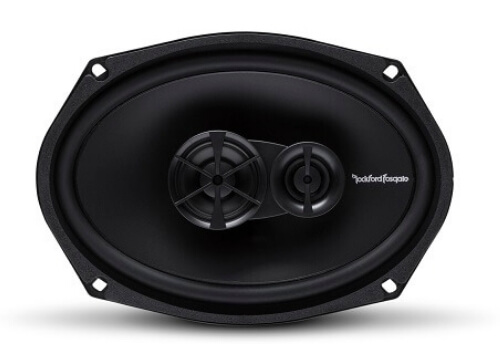
My next set of car speakers comes from Rockford Fosgate, a well respected brand in car audio industry. And these reasonably priced drivers are easy to install making them the best 6×9 speakers for a factory upgrade.
The 3-way speakers boast 65W RMS, which is significantly lower than the Hertz speakers above, but so is the price. As with most things in life, you get what you pay for and if you want a good speaker that performs well then these Rockford Fosgate R169X3 Prime are a good fit.
65W RMS will be a fantastic upgrade from your factory speakers, and the polypropylene cones and stamped basket ensures the woofer produces some surprisingly loud bass.
However, with a frequency range 47Hz – 20kHz the bass gets a bit distorted the higher you turn them up, so be wary of that if you like your music loud.
This speaker is more about the silk dome pole mounted Piezo tweeter and midrange, to be fair. These take care of the mids and highs, and thanks to the integrated tweeter crossover, the treble is fluent and clear.
The Sensitivity is decent at 90 dB, so the clarity as long as you’re not pushing them too hard and expecting too much bass, is surprisingly good.
If you’re just looking for a simple upgrade from your factory speakers, these are good enough and with a mounting depth of 2.85 inch, you should be able to easily replace them.
- Good price
- Clean highs
- Good factory upgrade
- Bass is lacking
- Distortion at higher volumes
Alpine SPE-6090 – Budget Speakers Under $100
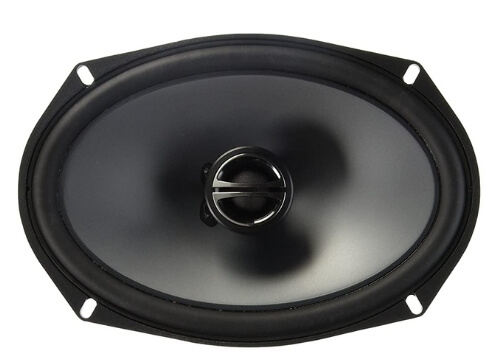
Alpine is one of the top brands in the car audio industry. For over 50 years, the Japanese manufacturer has been making reliable and quality car audio equipment and this Alpine SPE-6090 6×9 car speaker is another product maintaining its reputation.
The 2-way SPE-6090 speaker has been on the market for over 10 years now, but still sells well thanks to its quality features and reasonably price entry. That’s why it makes my list as the best 6×9 speakers for under $100.
Alpine claims this is the best budget speaker system, and it’s hard to argue with an RMS 75W per speaker the power handling of these coaxial speakers is impressive.
If you like it loud, and who doesn’t, the Sensitivity of these speakers is also impressive at this price entry at 91 dB, and thanks to the Polypropoleyne, Pearl Mica Injection cone the mids are resoundingly clear.
These 2-way 6 by 9 speakers’ are limited with frequencies and the narrow 65Hz-18000kHz frequency range is a bit truncated compared to some of its competitors.
However, the tweeter utilizes a dome architecture and a silk material construction, so you are sure to receive epic highs – not an over-exaggeration, and really these speakers will make a huge difference from your factory speakers.
Unfortunately, all things come at a cost and at this price point, you cannot expect the absolute best soundscape. The bass is a bit disappointing, especially for the brand, but anyone who’s seriously investing in a full car audio system, probably won’t look at these.
All in all, if you’re upgrading your factory speakers, these will make a huge difference. For me, they’re great 6x9s that are cheap, loud, clear, and a sensible replacement for anyone new to car audio.
- Great price entry
- Massive upgrade from stock speakers
- Loud and clear
- Highs can get a bit bright
- Lacking in good bass
Polk Audio DB692 DB+ Series – 6×9 Motorcycle and Marine Speakers
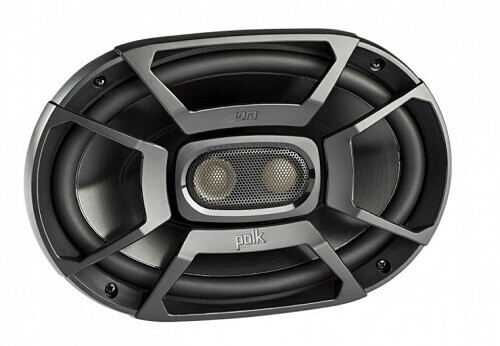
Polk Audio is another car audio manufacturer with a strong reputation built over several decades. Their equipment is known for its power and durability, and these speakers make my list as the best marine speakers, as well as for motorcycle and ATV owners.
Of course, boats and motorcycles need more volume as you’re exposed to the elements and not in an enclosed space, and these 6×9 speakers have an impressive 150W RMS per speaker, which ensures you get sufficient power, which is especially for the price entry.
The Polypropylene and UV tolerant cone with waterproof inner and outer surrounds ensures the mids are loud and clear, while resisting the elements of nature.
At 93 dB, the Sensitivity ensures you can run these from a factory head unit, but if you own a loud bike, you might have to add an external amplifier to really enjoy the clarity of the volume these exude.
The 3-way coaxial speaker’s Frequency Response is an impressive 30 Hz → 22 kHz, and the 0.75″ shallow tweeter design, made from non-resonant materials ensures the highs are warrm, but maybe not bright enough for some.
Of course the DB+ 6×9 speaker comes Marine certified with IP55 rating (water- and dirt-resistant) and has also been tested for salt-fog, UV and humidity. This makes them the ideal 6×9 speaker for anyone hitting the waves, off-road or any biker.
Whatever your need, these 6×9 speakers are a great factory replacement, even in a car, SUV etc. And whatever vehicle you upgrade them on, it will make a massive difference to the soundscape of your environment.
- Wide Frequency Response
- High and Powerful RMS
- Ideal marine speakers
- Highs aren’t as bright as others
- No rubber gasket for the back of the speaker
JBL GTO939 GTO Series – 6×9 Full Range Speakers
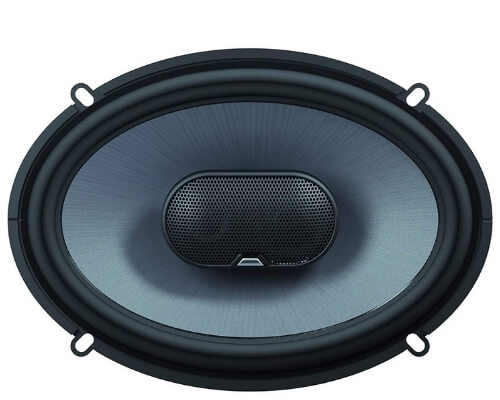
The next on my list are from JBL, a brand well-known for quality audio equipment. And as far as 6x9s go these GTO939 coaxials are the best speakers for a full range at this price entry.
The JBL GTO939 3-way 6×9 speakers have been on the market a long time, but they’re still selling well thanks to the quality features and powerful bass this set of drivers produce.
With only a 3-ohm impedance, the speakers can draw more power from your amplifier, and this gives the power handling of these little beasts at 100W RMS per speaker.
JBL’s Plus One cone material gives the GTO938 up to 30 percent more cone surface than competing models, and with an impressive 94 dB it ensures you’re getting a driver that’s higher efficiency and a better bass response, even running with a half decent factory car stereo.
The Mylar-Titanium composite dome tweeter produce extra smooth and detailed sound, and delivers rich sound through the midrange frequencies, and thanks to the built in crossover, it works between frequencies much more efficiently.
The 3-way speaker also boasts a Mylar-Titanium composite dome super tweeter, which benefits from a large voice coil, that’s typically found in high-end home audio speakers. This increases the power handling and reduces distortion at high output levels, meaning you can enjoy some bright highs with clarity not usually found in speakers of this price entry.
The Frequency response is a bit limited 45-21,000 Hz compared with some other speakers on my list, but the frequencies blend seamlessly, and nobody buys 6×9 speakers for their bass output. That’s not to say the bass isn’t decent because these loud beasts do push some decent bass.
These JBL 6×9 speakers work well with a factory head unit, but if you do pair them up with a good quality amplifier, they will deliver true, audiophile-quality performance worthy of any car stereo system.
- Significant upgrade from factory speakers
- Excellent midbass and highs
- More efficient than many other 6×9 speakers
- Bulky
Pioneer TS-A6990F – 5-Way Car 6×9 Speakers
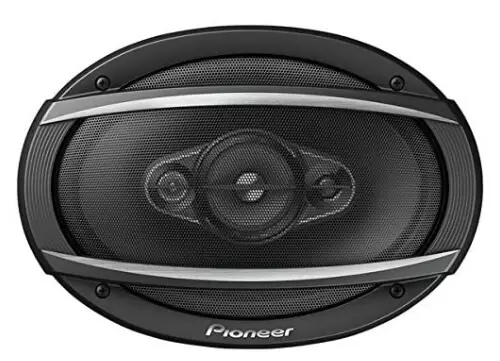
Pioneer has been leading the way for decades when it comes to refining the soundscape of audio equipment, and with this TS-A6990F 6X9 car speakers, they look to continue that trend.
As the only 5-way speaker system on my list, the A-series Pioneer easily outperforms any other drivers in its price range when it comes to mids and highs and even gives the premium-priced systems a run for their money.
The bass these speakers produce is a high standard, thanks to the speaker’s carbon and mica reinforced injection molded polypropylene (IMPP) woofer basket and oversized motor structure design, which ensures the full-range loudspeakers provide dynamic, high impact bass that almost resembles a subwoofer.
The triple polyethylene terephthalate hard dome tweeter ensures the highs are as bright as anything on my list, and thanks to Pioneer’s Open & Smooth sound concept the transition between the midrange and tweeter drivers is as smooth as any speaker and ensures you get a great overall sound fidelity.
And if you want total control over the sound reproduction, these speakers pair with Pioneer’s CarSoundFit app on your smartphone. This is basically a car sound simulator for experiencing in-car sound, and gives you more control over the 5-way speakers.
If you are tight for space, the mounting depth might be a problem for you so check out the size you can fit before buying. But of course, something so loud and powerful needs a bit of bulk, and if you opt for these Pioneer loudspeakrs, you will be delighted with the overall sound quality.
- Clean and clear sound
- Upper & lower range are superb
- Loud
- Bulky s be careful if you drive a small car.
Kenwood KFC-6966S – 6×9 Car Speakers Under $50
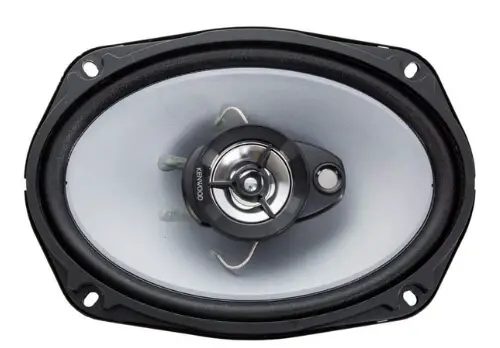
Kenwood is another stellar name in the audio and electronics industry, and they’re known for making good quality products at a reasonable price. And these KFC-6966S 6×9 3-way coaxials are the best cheap speakers you’ll find for under $50.
A 3-way coaxial speakers for under $50 means the materials are limited, but for the price, I do like them. To keep the price down, Kenwood limited the RMS to 45W per driver, so don’t expect to rock everyone else’s world.
But don’t think they’re quiet, because you can get decent volume from them, because the polypropylene woofer cones will enrich your music with solid midbass and dynamic midrange, and if you are replacing your old factory speakers, the difference will be huge.
That low power handling also restricts the bass response of these 6×9 car speakers, so if bass is your thing, you might be better spending a bit more and getting something else.
The speakers boast 1″ balanced-dome tweeters and ceramic supertweeters that offer a full spectrum of melodies in the high range
What is impressive in these cheap speakers is the 92 dB sensitivity, which should mean you won’t need an external amplifier, and also means you’ll save even more money.
To be honest, if you do intend to get an external amplifier, I wouldn’t bother with these. Sure, they’ll sound better than with your head unit, but if you intend spending more on a full car stereo system, I would recommend a better set of drivers.
But the great thing about these 6x9s, you can safely power them with your car stereo and still enjoy your music the way it was meant to be heard, with clarity and emotion.
All in all, these are good car speakers for under $50. For that price you can crank them up, power them with your car stereo and still enjoy your music without being fearful of running your expensive speakers into the ground. A good factory upgrade.
- Good cheap speakers
- Big upgrade from stock speakers
- Soundscape that isn’t possible with factory speakers
- RMS is low for aftermarket speakers
- Limited bass
Focal 690AC Access – 6×9 Car Speakers For Sound Quality
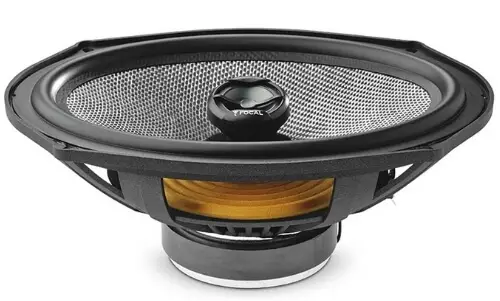
I’ve saved the best 6×9 speakers for sound quality until last, and the quality is pristine, but with it comes a cost. These Focal 690AC speakers aren’t cheap, but if you really care about the clarity of a full-range sound and you’re happy to pay more then these are the speakers for you.
Sporting a coaxial design, the aluminum dome tweeter, and woven glass fiber woofer combines to reproduce almost any sound with crystal clarity, and believe me, you will hear sounds that you’ve never heard in songs before.
For the price, the power handling is a bit low at 75W RMS per speaker, but with a Sensitivity of over 91 dB it’s powerful enough and whatever genre of music you play will sound enhanced.
Composed with 90° woven glass fibre and insulated with polyurethane, the woofer cone resists to extreme acoustic environments and harsh weather conditions.
And with the Kapton-mounted dual-layer 30mm coil the driver reproduces distortion-free sound and some crisp midbass that is hard to match.
The speaker boasts a built-in crossover, which allows the woofer and tweeter to seamlessly work together, and with the tweeter mounted on a rotativ pod, it allows you to optimize your sound stage to your liking as and when you change your music.
The Frequency Response is surprisingly limited at 50Hz – 20k Hz, but to be honest you would never notice this. After all, the bass is impressive for a 6×9 speaker thanks to the texture of the cone.
Another bonus for these Focal 690AC speakers is that they perform very well even with a modest head unit, so there’s no need to spend more on an external amplifier, unless you’re an audiophile of course.
Overall these are the best 6×9 speakers for sound quality. The woven glass fiber woofer, and the rotativ aluminum dome tweeter expel some resounding midbass and magnificent highs. And to think they’re only 2-way coaxial speakers. If you can afford these, you will be happy you bought them.
- The best clarity of soundscape from coaxial speakers
- High-quality materials throughout
- Adjustable tweeters on a coaxial unit is nice
- Great bass for 6x9s
- Expensive
Infographic

Buyer’s Guide
How does a component and a coaxial speaker differ?
There’s no definitive answer to the best car speakers, it’s all about personal preference and many are divided about coaxial and component speakers.
These are the two primary types of 6X9 speakers. Each has their advantages and disadvantages, so you must weigh carefully what you want and what you are capable of accommodating ahead of time. At their most basic the difference between a coaxial, or full-range, and a component speakers system has more to do with where the different parts of the speaker are located.
With component stereo systems, the speakers which handle the lows, mids, and highs are all separate from one another. This can technically allow for the best listening experience because you are given the option to adjust the speakers, both externally and internally, which allows far more variation and customization than with a coaxial setup.
However, component speakers cost more of everything. First, with 3 separate components, this speaker system will occupy far more physical space. What’s more, the arrangement of those components in that space will heavily influence the ultimate quality of the listening experience.

Also, component stereo systems have a tendency to consume more power. With 3 separate lines to feed per speaker system, component speakers often require far more powerful and advanced amps.
Finally, component stereo systems are simply more expensive in general. Aside from the fact that you often need a more powerful, and and expensive amp and monitoring system, you will also often need to purchase the components separates, though you can often find bundle deals.
Coaxial speaker systems, by comparison, are far easier and cheaper to deal with. With coaxial speakers all of the different speakers: lows, mids, and highs are stacked on top of one another.
This is not only more cost effective and space saving, it generally requires lower power outputs which means you do not need as good of an amp to effectively run them.
However, while coaxial speakers generally produce a smoother soundscape, they do have a limit, and the different frequency ranges can muddy one another if the speakers are not of a high enough quality.
Do I need to get an amplifier for 6×9 speakers?
You don’t need an amp for 6×9 speakers per se, but of course there are some great advantages by driving your speakers from a good quality amp.
If the power consumption of your speaker system is high, you will definitely be better getting a separate car amplifier. This is especially relevant for high-quality speaker systems which generally require far more power than a basic car’s power control system can manage. Even for luxury vehicles, a top of the line stereo system will often be better served by an external amplifier.
Of course there are benefits to getting an amp. it will ensure any speaker has lower distortion and a cleaner sound. And the crossover in the amp will allow you to block out low end bass, which will save on power, which means more pwoer going towards the volume.
Even if the vehicle’s amplifier is well-rated, an external amplifier will handle the energy transfer to the various speakers more efficiently and prevent the energy from becoming dirty with interference.
However, for mid-tier or lesser quality 6X9s, I wouldn’t spend the extra on a good quality amp. That’s not to say there won’t be an improvement in the soundscape, because there will, it’s just that your speakers won’t be able to make full use of the amp’s specs and for me it’s pointless spending all that money if you can’t utilise the amp fully.
For most people, listening to music through 6×9 speakers at a moderate to moderately high volume with a good head unit will offer more than adequate sounds. However, using an amp can take your audio system to the next level, and that’s what most audiophiles crave.
Can 6X9 speakers drive powerful bass?
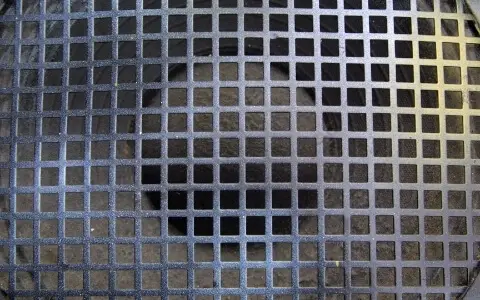
Since the bass produced by a speaker is directly correlated to the size of the speaker’s membrane, the question of whether or not a 6X9 can produce powerful bass will hinge heavily on how you define the term “powerful”.
If you are looking for bass that will rattle the fluid inside of your ears and make your vision blur, then no, 6X9 speakers do not provide powerful bass, regardless of the quality.
However, if you are simply looking for bass that is loud enough to either provide a good punch or a rich, deep, dulcet tone, then there are plenty of 6X9 speakers capable of handling this job. Of course, the higher end speakers will also often require an external amplifier to produce the best bass, but again it’s not a necessity for many.
In fact, unless the speakers are extremely modest in the total power they consume and can use to push the sound, most 6x9s, regardless the quality, will produce better bass when hooked up to an external amplifier.
Just be sure that you do not set up your speaker system to push too much power at once or else you risk blowing out your speakers sooner.
Are 6.5 speakers better than 6×9 speakers?
That’s the age old debate, but as with everything else in the car audio industry, there’s no definitive correct answer. There are many 6.5 speakers that beat 6x9s, while the opposite is also correct. It all depends what you’re looking for and your system set up.
There’s a myth that 6×9 speakers are no good for bass and even overall sound quality, but it’s not true. There are many good car speakers out there of all sizes, and a bit of research will show you that.
But with the 6×9 vs 6.5 debate. Assuming all things are equal, including proper installation, the same power source etcetera, 6×9 speakers will outperform identical 6.5 inch speakers. However, if you are looking to get a subwoofer, a set of 6.5 speakers might be a better option.
Speaker Specifications
Speaker Materials
This is arguably the most important quality to consider when selecting any speaker, not just 6x9s. The quality of the materials will directly determine the quality of the soundscape produced as well as the longevity of the speakers. However, each part of the speaker will require different materials to produce the best sound.
The woofer materials should be both lightweight and stiff. This generally takes one of 2 forms:
- Woven fabrics coated with light metals
- Synthetic films mixed with crystalline coatings
Option 2 generally produces more accurate bass, but the former will often be a more durable speaker.
Tweeters, the speakers that produce the highs in a 6X9, can utilize similar materials as the woofer, specifically the synthetic poly blends. However, these speakers generally perform best when the membrane is made out of silk. However, if you prefer brighter highs, you might want to look for tweeter membranes made out of metals, graphite, ceramics, or other high-quality, hard materials.
[table id=2 responsive=scroll /]
Power Consumption (RMS)
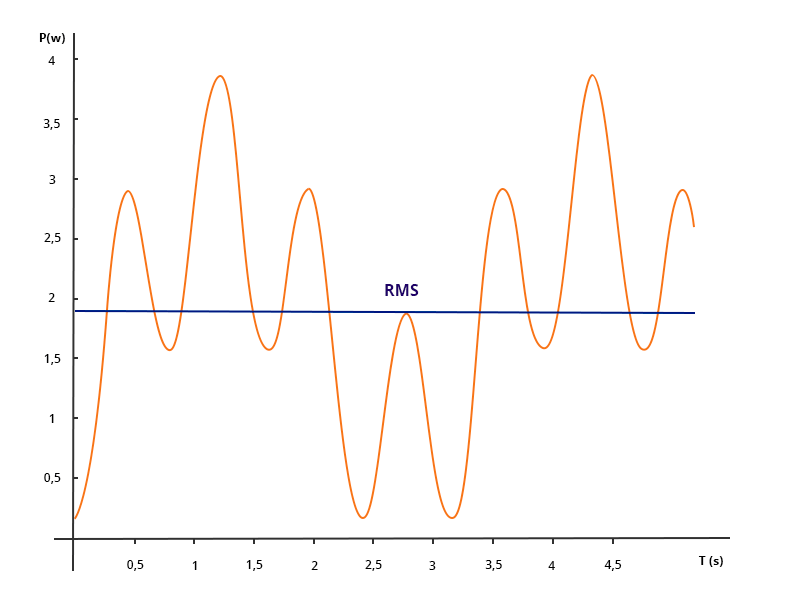
This quality is generally measured in watts with the higher the watts, the more power the speakers can handle. This has a direct correlation to the volume at which the speaker can produce as well as the quality, though the speaker’s materials will also play an important role in this.
When looking at a speaker system’s wattage, it is important to focus more on RMS, or “root mean square,’ wattage than peak wattage. RMS is a more accurate representation of the power consumption as it applies to the speaker’s ability to produce a quality soundscape.
Keep in mind, if your speaker system has low RMS wattage, you likely do not need an external amplifier nor will you truly be well-served in having one. However, a speaker system with high RMS values will almost certainly require an external amplifier, so it’s important to make sure those specs match both parts of the system.
Sensitivity
Essentially, the sensitivity of a speaker is how much sound it can produce based on the amount of power it consumes. Technically, this is a measurement of efficiency, though it does have implications at the extreme end of the volume spectrum.
If there is a number that tells you the speaker’s sensitivity, it would be the decibels or dBs. Keep in mind, the higher sensitivity (over 90 dB) the louder sound in general requires less power. If you have low sensitivity speakers they may require an amplifier but they will drive good quality sound.
Impedance
This quality alone may be the determining factor in whether you need an external amplifier or not. The higher the impedance, measured in ohms (Ω), the more power the speakers require to produce the same level of volume.
However, higher impedance speakers are often easier on amplifiers, requiring less baseline power to function in the first place. Whereas, speakers with lower impedance will be more demanding on the amplifier over a continuous duration of time.
One thing to keep in mind is that the ohms of the speaker and the ohms of the amplifier need to match. Many high-end amplifiers are able to push various ohms, though the watts will differ depending on the impedance itself.
Be warned, however, some lower quality amplifiers may only be suited for a single impedance rating. So, if you use a low-end amplifier and speaker at misaligned impedance ratings, the sound quality will likely suffer as a result.
How big is a 6×9 Speaker?
I know what some of you are thinking right now:
Wait, how big is a 6×9 inch speaker? I thought they were 6” x 9”.
Technically, this is true accurate, but size relates specifically to the surface area of the speaker’s membrane, not necessarily the entire speaker itself. As such it’s possible to purchase 2 different 6X9 speakers that are different in overall size.
The most common, if not only, cause for this discrepancy has to do with the speaker’s housing. If the housing is fairly large, that 6X9 could end up being a foot or bigger long and over 8” wide–not to mention whatever depth measurement it would clock in at.
Ultimately, the best thing to do is to look at your user manual or some other set of specs which will tell you the space measurements where your current speakers reside.
If that information isn’t available, you can always measure it yourself. However, those measurements can often be imprecise, so you should estimate less than you actually perceive just to be on the safe side.
FAQ
So What Are The Best 6×9 Speakers On The Market?
Are you really asking that question after reading this review? ha ha. No seriously, there’s no definitive answer and the best car audio speakers for me won’t match that for most other people.
There are many great speakers on the market, and whether you like deep bass, good quality mid-to-highs, or are after the crispest music at high volumes, the best 6×9 speakers depends on personal taste.
As we know, there are myths surrounding 6×9 speaker quality, but myths belong in the children’s library. Whatever your taste, you can get what you want with 6x9s, it just takes a bit of research. And a good place to start is the speakers table above.
If you get a good set of speakers with an external amplifier, and a good quality head unit, you will reproduce a pristine soundscape that will make your every drive much more enjoyable.

I am a passionate and skilled car audio enthusiast with 15 years of experience in the industry. My journey started when I replaced my first set of factory car speakers, sparking a deep love for high-quality sound. Since then, I have worked as a representative for renowned brands like Kenwood and Alpine.
With a background in both retail and distribution, I have developed a comprehensive understanding of the car audio market. Currently a certified (MECP) installer in the Mobile Electronics industry, my expertise lies in delivering top-notch audio installations. My knowledge, coupled with my genuine passion, makes me the go-to professional for all car audio needs.


At the top of the page you have the rms watts of the pioneers at 100 but then in the con section you say it is 50.
You are right! 100 Watts Nominal. Thank you!
Pioneer pro series!!
1993 called and they want their outdated brands back. You missed most of the market in your review. Focal, Digital Designs, Skar, Crescendo, Massive, Audio Frog, Stevens Audio, OnCore, Morel, etc… All make phenomenal speakers, some of which should have made your list
I have to agree and likes of sundown and nvx also amazing sound quality and massive bass
You say that you can’t get earth shattering bass from such a small speaker but there is a couple brands like sundown that have 6.5 in that can put some 12 in to shame.
I have to agree sundown has excellent quality and especially in the bass category, but i have to say that is an overstatement to say 6.5s will but a 12” to shame. It would have to be a very cheap subwoofer in which i would not even consider as an option! Lol
I can’t disagree with that.
Where can I find sundown speakers at ??
Sundown Audio SA-69CX
The sundown 6×9 you recommended. Are they better bass than the kickers in your opinion/experience?
Assuming you mean midbass and not sub bass. I would look at Sundown, Alpine R-series, Pioneer D-series. With 6×9 speakers, you won’t get “thumpin” bass.
Can I get the pros/cons of putting speaker baffles around my 6×9 speakers?
Hi Tom,
The only pro is weather protection. Didn’t notice any difference in sound. Sound deadener makes a world of difference not only with sound quality but overall noise from outside.
I went with a Hertz Audio 4 channel amp and 2 Hertz Audio 6×9’s. It’s exactly what I wanted! Thanks for all the help!
Hi Anthony,
Glad you’re enjoying it!